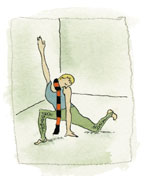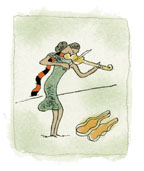
|
|
January 25, 2006: Features
 The
arts at Princeton:
The
arts at Princeton:
What the future may hold
By Brett Tomlinson
Illustrations by Marc Rosenthal ’71
The recorded auditions arrive by the hundreds each fall and winter as Princeton’s early and regular admission periods draw to a close. In some of the tapes (officially, optional supplements to the application package), an excited parent operates the camera from the back of a high school auditorium, trembling with pride. But most of the submissions have a more refined look. Lily Cowles recalls sending a DVD of clips from her performance as Mercutio in a summer production of Romeo and Juliet at Oxford University in hope of standing out among 16,000 applicants.
“No one thought I’d get in [to Princeton],” Cowles says, recalling comments by students at her boarding school, where she had studied theater and acted in school plays. “[But] I thought maybe I had something I could offer. I had a hook.”
Cowles was right. She is now a member of the Class of 2009 — and had a lead role in the theater program’s fall production, A Long History of Neglect. (The other lead also was played by a freshman, Sam Zetumer, cast as a 13-year-old boy.) And according to faculty in the creative and performing arts, a growing number of Princeton applicants are casting a similar lure: great artistic talent informed by extensive training. While not all of those gifted high school seniors end up on campus, the ones who do are making a discernable impact on the University’s performing groups and arts programs. Dance, which once tilted heavily toward beginners, has added sections to its advanced courses. The by-application-only courses in creative writing are routinely oversubscribed. The visual arts have seen an infusion of interest, particularly in photography and video and film courses, and musical performance ensembles are flourishing.
Student artists are coming to Princeton for a variety of reasons. Creative writers are drawn by the extraordinary faculty, which includes a half-dozen Pulitzer Prize winners. Dancers enjoy the chance to take dance courses for academic credit, an opportunity not available at Harvard or Yale. In music, the introduction of the University’s certificate in musical performance more than a decade ago has spurred a steady growth in the roster of performers. Michael Pratt, the program’s director and the conductor of the University Orchestra, says that the talent level of Princeton musicians has grown to a point that he previously had not dreamed possible. “We’ve always had a handful of really gifted performers here,” he says. “What has happened is not so much that the best people now are better than the best people then. It’s just that there are more of them.”
 According
to President Tilghman, while Princeton’s arts programs are thriving,
they also are struggling to keep pace with a growing demand for creative
outlets. “If we are not going to meet the needs of these students
in the future, they are going to go elsewhere, because our competitors
are paying attention to these trends,” she said at a November meeting
of the Council of the Princeton University Community (CPUC). Tilghman
wants the University to provide more opportunities for its most accomplished
artists and at the same time encourage novices to explore courses in the
arts, and she asked a faculty task force to recommend areas in which the
University could “make an investment” in the area. Led by
chairman Stanley Allen *88, dean of the School of Architecture, the task
force delivered a candid but confidential report to Tilghman in the summer,
and an arts initiative was scheduled to be discussed by University trustees
at their Jan. 21 meeting.
According
to President Tilghman, while Princeton’s arts programs are thriving,
they also are struggling to keep pace with a growing demand for creative
outlets. “If we are not going to meet the needs of these students
in the future, they are going to go elsewhere, because our competitors
are paying attention to these trends,” she said at a November meeting
of the Council of the Princeton University Community (CPUC). Tilghman
wants the University to provide more opportunities for its most accomplished
artists and at the same time encourage novices to explore courses in the
arts, and she asked a faculty task force to recommend areas in which the
University could “make an investment” in the area. Led by
chairman Stanley Allen *88, dean of the School of Architecture, the task
force delivered a candid but confidential report to Tilghman in the summer,
and an arts initiative was scheduled to be discussed by University trustees
at their Jan. 21 meeting.
The possibility of expansion has been greeted with enthusiasm from Princeton’s arts community, a sometimes-overlooked portion of the academic spectrum. Stretched to the limit, the most popular classes are turning away students. Applicants for photography classes taught by professor Emmet Gowin, for example, outnumber openings by 6 to 1, Allen said at the November CPUC meeting. The phased expansion of the freshman classes, which began last fall, could create an additional strain. “We’ve been led to believe that a higher proportion of those students will be these artistically inclined types, so there will be even more demand put on our facilities and our staff,” says Scott Burnham, chairman of the music department and a member of the arts task force.
High on the list of priorities is a need for space — space to create and rehearse, space to store instruments, or even computer memory space to house a growing library of work by student filmmakers and digital photographers (a need that was partially addressed recently with the addition of a new server, according to Eve Aschheim, director of the program in visual arts). The crunch affects both academic programs and extracurricular groups, which grow each year. In music, the jazz program alone has two 17-piece ensembles and a handful of smaller groups. The University Orchestra has about 100 musicians, with additional students involved in the University Sinfonia, a chamber orchestra, and a student-run wind ensemble. The Woolworth Center, home of the music department, was expanded in 1997, and since then, most of the University’s a cappella groups have moved to rehearsal spaces in the basement of Bloomberg Hall. But Burnham says the department still has to juggle room assignments. At 185 Nassau Street, home of the visual arts, creative writing, and theater and dance, acting head of dance studies Rebecca Lazier says she has seen as many as five dance groups practicing in the same studio at the same time.
Many students and faculty, including several who served on the task force, would like to see the construction of a new performing arts building to alleviate some of the current space constraints; more course offerings, both to meet the demand in oversubscribed courses and fill in gaps in the curriculum; and more faculty — both permanent and visiting — to teach the expanded offerings. Adding majors to the certificate-only programs in theater and dance is another request, according to Ze’eva Cohen, a dance professor in the Council of the Humanities. Cohen supports the idea of a dance major, provided it covers “dance in a liberal arts context” — a holistic curriculum of history and analysis, in addition to technique and choreography. Michael Cadden, the director of the Program in Theater and Dance, says that he is ambivalent about the importance of offering a theater major. While a major might help to recruit high school seniors, he says, it is not an “absolute necessity,” adding that theater and dance is “enriched as a program by the fact that everyone in the program has a foot somewhere else at the University.”
Beyond the potential changes in facilities, curriculum, and the faculty, departments and programs in the arts want to “dream bigger,” as Lazier puts it, through collaborations that span several departments. Last March, Princeton students and faculty joined with a renowned professional choreographer and a theater historian to re-create Le Pas D’Acier, a ballet by Sergei Prokofiev that had not seen the stage in nearly 80 years. Professor Simon Morrison *97, a musicologist, researched the piece in Prokofiev’s archives and set the project in motion. The University Orchestra played the score for 30 student dancers, who performed for sellout crowds on three consecutive nights in McCarter’s Berlind Theatre. Burnham, whose music department staff worked behind the scenes on the project’s logistics, called the on-stage performance a “spectacular success.” At the same time, he says, it “illuminated, pitilessly, the problems that we have in making these collaborations come to life.” A shortage of staff and piecemeal funding, for example, forced everyone involved to devote extra time to the project, Burnham says. To address those problems, he envisions a centralized University agency for arts production with the resources and expertise to coordinate large interdepartmental collaborations. “Arts events are hand-wrapped events — there’s no cookie cutter,” he says. “Every event has contingencies and conditions and is labor-intensive. There’s no way around it.”
Faculty members hope to see Princeton become a home for the creation of new art, through visiting residencies for emerging artists or established professionals. A few programs are already in place or on the horizon, including the Hodder Fellowships for promising young writers (a Council of the Humanities program that began in the 1940s and was expanded in the last decade), and playwright Edward Albee is expected to come to Princeton in January 2007 to develop a new play at McCarter Theatre and to teach a theater course at the University. Cadden says that by supporting new art, the University can inspire and attract students and in the process “brand” Princeton as “a place where people who are serious in the arts might want to come and work.”
By raising the arts as a topic for campus conversation, Tilghman already
has given the creative and performing arts community a boost in visibility
on campus to complement the rising level of skill among students. Cohen,
who has taught dance at Princeton since 1969, says that the arts will
not forget their roots as an outlet for beginners in search of new forms
of expression, but the future will look toward deeper experiences. “You
have other people at Princeton who graduate and make a difference in the
world, and we’d like to do the same in the arts,” Cohen says.
“We can’t without having more serious study.” ![]()
Brett Tomlinson is an associate editor for PAW.
